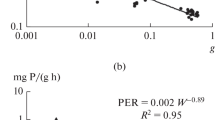Abstract
Respiration and nitrogen excretion rates of mature adult Loligo forbesi were investigated at the Roscoff Laboratory (North Brittany, France) during individual short-term incubation experiments in January 1986. The squids were in post-digestive condition and not actively swimming. Both oxygen uptake and nitrogen excretion are continuous processes. The metabolic rates of this active nektonic species (145 ml kg-1 h-1 oxygen uptake, 18.56 μg g-1 h-1 ammonia excretion) are distinctly higher than those of benthic cephalopods. Proteins constitute the main metabolic substrate for energetic needs. Besides ammonia, urea is also continuously released, in amounts ranging from 5 to 16% of ammonia-excretion values.
Similar content being viewed by others
Literature cited
Aminot, A., Kerouel, R. (1982). Dosage automatique de l'urée dans l'eau de mer: une méthode très sensible à la diacétylmonoxime. Can. J. Fish. aquat. Sciences 39: 174–183
Boucher-Rodoni, R., Mangold, K. (1985). Ammonia excretion during feeding and starvation in Octopus vulgaris. Mar. Biol. 86: 193–197
Boucher-Rodoni, R., Mangold, K. (1988). Comparative aspects of ammonia excretion in cephalopods. Malacologia 29: 145–151
Bradbury, H. E., Aldrich, F. A. (1969). Observations on locomotion of the short-finned squid, Illex illecebrosus (Lesueur, 1821), in captivity. Can. J. Zool. 47: 741–744
Conover, R. J., Corner, E. D. S. (1968). Respiration and nitrogen excretion by some marine zooplankton in relation to their life cycle. J. mar. biol. Ass. U.K. 48: 49–75
Delaunay, H. (1931). L'excrétion azotée des invertébrés. Biol. Rev. 6: 265–301
Emmanuel, C. F. (1957). The composition of octopus renal fluid. II. A chromatographic examination of the constituents. Z. vergl. Physiol. 39: 477–482
Emmanuel, C. F., Martin, A. W. (1956). The composition of octopus renal fluid. I. Inorganic constituents. Z. vergl. Physiol. 39: 226–234
Forster, R. P., Goldstein, L. (1969). Formation of excretory products. In: Hoar, W. S., Randall, D. J. (eds.) Fish physiology. Vol. 1. Excretion, ion regulation and metabolism. Academic Press, New York, p. 313–350
Fürth, O. von (1900). Über den Stoffwechsel der Cephalopoden. Z. phys. Chem. 31: 353–380
Goldstein, L., Forster, R. P., Fanelli, G. M., Jr. (1964). Gill blood flow and ammonia excretion in the marine teleost, Myoxocephalus scorpius. Comp. Biochem. Physiol. 12: 489–499
Hoeger, U., Mommsen, T. P., O'Dor, R., Webber, D. (1987). Oxygen uptake and nitrogen excretion in two cephalopods, octopus and squid. Comp. Biochem. Physiol. 87A: 63–67
Lindemann, W. (1900). Uremie bei Cephalopoden. Beitr. path. Anat. 27: 491–493
O'Dor, R. K. (1982). Respiratory metabolism and swimming performance of the squid, Loligo opalescens. Can. J. Fish. aquat. Sciences 39: 580–587
O'Dor, R. K., Mangold, K., Boucher-Rodoni, R., Wells, M. J., Wells, J. (1984). Nutrient absorption, storage and remobilization in Octopus vulgaris. Mar. Behav. Physiol. 11: 239–258
Potts, W. T. S. (1967). Excretion in the molluscs. Biol. Rev. 42: 1–41
Regnault, M. (1981). Respiration and ammonia excretion of the shrimp Crangon crangon L. Metabolic responses to prolonged starvation. J. comp. Physiol 4: 549–555
Segawa, S., Hanlon, R. T. (1988). Oxygen consumption and ammonia excretion rates in Octopus maya, Loligo forbesi and Lolliguncula brevis (Mollusca: Cephalopoda). Mar. Behav. Physiol. 13: 389–400
Solórzano, L. (1969). Determination of ammonia in natural waters by the phenolhypochlorite method. Limnol. Oceanogr. 14: 799–801
Stickle, W. B., Bayne, B. L. (1982). Effects of temperature and salinity on oxygen consumption and nitrogen excretion in Thais (Nucella) lapillus (L.). J. exp. mar. Biol. Ecol. 58: 1–17
Udenfriend, S., Stein, S., Bohlen, P., Dairman, W., Leimgruber, W., Weigele, M. (1972) Fluorescamine: a reagent for assay of amino acids, peptides, proteins and primary amines in the picomole range. Science, N.Y. 178: 871–872
Wells, M. J., O'Dor, R. K., Mangold, K., Wells, J. (1983a). Feeding and metabolic rate in Octopus. Mar. Behav. Physiol. 9: 305–317
Wells, M. J., O'Dor, R. K., Mangold, K., Wells, J. (1983b). Oxygen consumption in movement by Octopus. Mar. Behav. Physiol. 9: 289–303
Author information
Authors and Affiliations
Additional information
Communicated by J. M. Pérès, Marseille
Rights and permissions
About this article
Cite this article
Boucher-Rodoni, R., Mangold, K. Respiration and nitrogen excretion by the squid Loligo forbesi . Mar. Biol. 103, 333–338 (1989). https://doi.org/10.1007/BF00397267
Accepted:
Issue Date:
DOI: https://doi.org/10.1007/BF00397267



